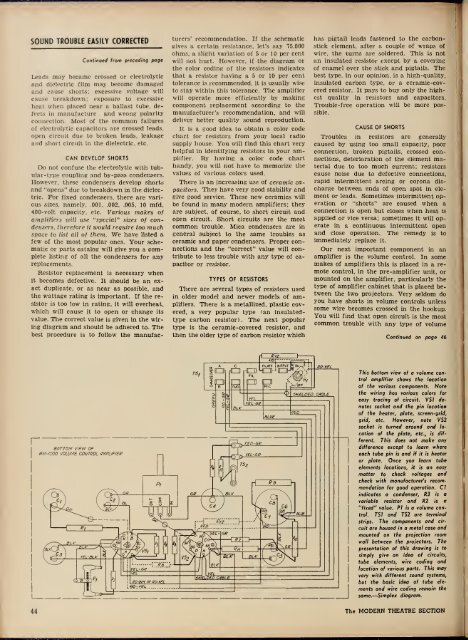Boxoffice-April.07.1958
Create successful ePaper yourself
Turn your PDF publications into a flip-book with our unique Google optimized e-Paper software.
SOUND TROUBLE EASILY CORREaED<br />
Continue from preceding page<br />
Leads may became crossed or electrolytic<br />
and dielectric film may become damaeed<br />
and cause shorts: excessive voltage will<br />
cause breakdown: exposure to excessive<br />
heat when placed near a ballast tube, defects<br />
in manufacture and wrong jwlarity<br />
connection. Most of the common failures<br />
of electrolytic capacitors are crossed leads,<br />
op)en circuit due to broken leads, leakage<br />
and short circuit in the dielectric, etc.<br />
CAN DEVELOP SHORTS<br />
Do not confuse the electrolytic with tubular-type<br />
coupling and by-pass condensers.<br />
However, these condensers develop shorts<br />
and "opens" due to breakdown In the dielectric.<br />
For fixed condensers, there are various<br />
sizes, namely. .001. .002. .005, 10 m^d.<br />
400-volt capacity, etc. Various makes of<br />
amplifiers will use "special" sizes of condensers,<br />
therefore it would require too much<br />
space to list all of them. We have listed a<br />
few of the most popular ones.<br />
Your schematic<br />
or parts catalog will give you a complete<br />
listing of all the condensers for any<br />
replacements.<br />
Resistor replacement Is necessary when<br />
It becomes defective. It should be an exact<br />
duplicate, or as near as possible, and<br />
the wattage rating Is important. If the resistor<br />
is too low in rating, it will overheat,<br />
which will cause It to open or change its<br />
value. The correct value is given in the wiring<br />
diagram and should be adhered to. The<br />
best procedure is to follow the manufacturere'<br />
recommendation. If the schematic<br />
gives a certain resistance, let's say 75,000<br />
ohms, a slight variation of 5 or 10 per cent<br />
will not hurt. However. If the diagram or<br />
the color codinn of the resistors indicates<br />
that a resistor having a 5 or 10 per cent<br />
tolerance is recommended, it is usually wi.se<br />
to stay within this tolerance. The amplifier<br />
will operate more efficiently by makinR<br />
component replacement according to the<br />
manufacturer's recommendation, and will<br />
deliver better quality sound reproduction.<br />
It is a good idea to obtain a color code<br />
chart for resistors from your local radio<br />
supply house. You will find this chart very<br />
helpful in identifying resistors in your amplifier.<br />
By having a color code chart<br />
handy, you will not have to memorize the<br />
values of various colors used.<br />
There is an increasing use of ceramic capacitors.<br />
They have very good stability and<br />
give good service. These new ceramics will<br />
be found in many modern amplifiers: they<br />
are subject, of course, to short circuit and<br />
open circuit. Short circuits are the most<br />
common trouble. Mica condensers are in<br />
general subject to the same troubles as<br />
ceramic and paper condensers. Proper connections<br />
and the "correct" value will contribute<br />
to less trouble with any type of capacitor<br />
or<br />
resistor.<br />
TYPES OF RESISTORS<br />
There are several types of resistors used<br />
in older model and newer models of amplifiers.<br />
There is a metallized, plastic covered,<br />
a very popular type

















